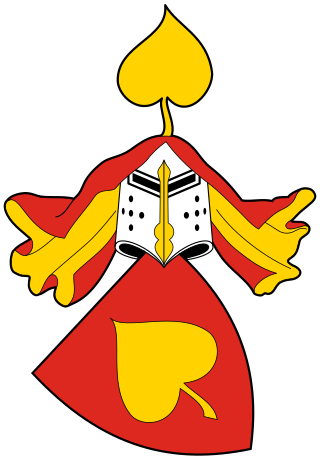Related Research Articles

Zsámbék is a town in Pest County, Hungary.

Osl was the name of a gens with Hungarian origin in the Kingdom of Hungary, based in today's Győr-Moson-Sopron County and in the Banate of Severin. The village of Osli was named after that clan. Also the Oslea mountain in the former Banate of Severin.

Rátót was the name of a gens in the Kingdom of Hungary. According to Simon of Kéza and other chroniclers, the ancestors of the clan were Italians from Caserta, Naples, by name Rathold and Oliver, who settled down in Hungary around 1097 during the reign of Coloman, King of Hungary. They came to Hungary alongside Felicia of Sicily.
Smaragd (II) from the kindred Smaragd was a Hungarian distinguished nobleman from the gens Smaragd, who held several positions during the reign of Andrew II of Hungary.
Smaragd (III) from the kindred Smaragd was a Hungarian prelate in the 13th century, who served as archbishop of Kalocsa from 1257 to 1265.
Bogátradvány was the name of a gens in the Kingdom of Hungary. The powerful Rákóczi family ascended from this genus.
Pápa was the name of a gens in the Kingdom of Hungary, in the Árpádian era.
Monoszló was the name of a Slavonian-origin gens in the Kingdom of Hungary. Several prominent secular dignitaries came from this kindred.

Hahót or Hahót–Buzád was the name of a gens in the Kingdom of Hungary, several prominent secular dignitaries came from this kindred. The last noble family, which originated from the kindred, became extinct in 1849.
Szécs was the name of a gens in the Kingdom of Hungary.
Báncsa or Bancsa, also incorrectly Vancsa or Vancza, was the name of a gens in the Kingdom of Hungary.
Péc or Pécz was the name of a gens in the Kingdom of Hungary. The powerful and illustrious Marcali and Apponyi noble families descended from this kindred. The clan had large-scale possessions in several counties of Transdanubia, in addition to Slavonia and other parts of the Kingdom of Hungary.
Stephen (I) from the kindred Rátót was a Hungarian lord in the 13th century, who served as Master of the treasury. He was a prominent member of the queenly court for years. His acquisitions of lands in Central Hungary proved to be basis for establishment of his clan's province during the era of feudal anarchy.

Héder was the name of a gens in the Kingdom of Hungary, several prominent secular dignitaries came from this kindred. The ancestors of the kindred were two German knights from the Duchy of Swabia, brothers Wolfer and Héder. They were granted large-scale domains in Western Hungary. The powerful and influential Hédervári and Kőszegi noble families descended from them.
Budmér was the name of a minor gens in the Kingdom of Hungary, which possessed lands in Southern Transdanubia, mostly Baranya County.
Bő was the name of a gens in the Kingdom of Hungary, which initially possessed landholdings and villages in Somogy County. Among other families, the Túz de Lak noble family descended from them.
Aynard from the kindred Smaragd was a Hungarian distinguished nobleman in the 13th century, who held positions during the reign of King Béla IV of Hungary.
John from the kindred Smaragd was a Hungarian nobleman at the turn of the 13th and 14th centuries, who served as ispán of Bács County in 1291. He led an unsuccessful Serbian invasion against Upper Syrmia in 1309–1310.
Gilét (I) from the kindred Smaragd was a Hungarian nobleman in the 13th century. The influential Zsámboki family ascended from him.
Egidius from the kindred Smaragd was a Hungarian distinguished nobleman at the turn of the 12th and 13th centuries. Originating from a kinship of French origin, he established a Premonstratensian monastery in Zsámbék.
References
- ↑ (in Hungarian) Veér, Zoltán: A Veér család eredete
